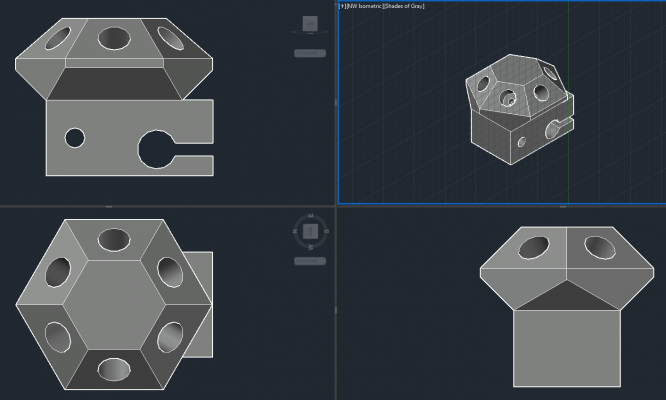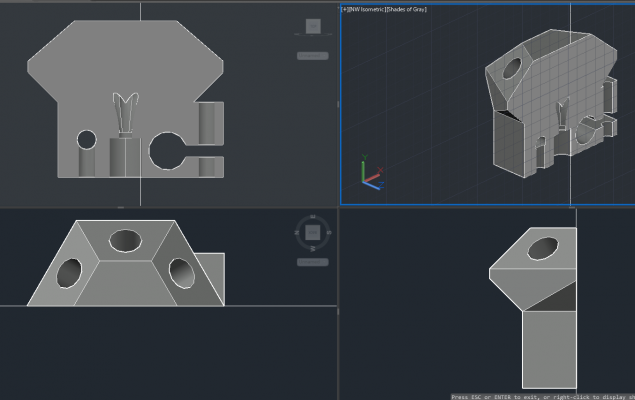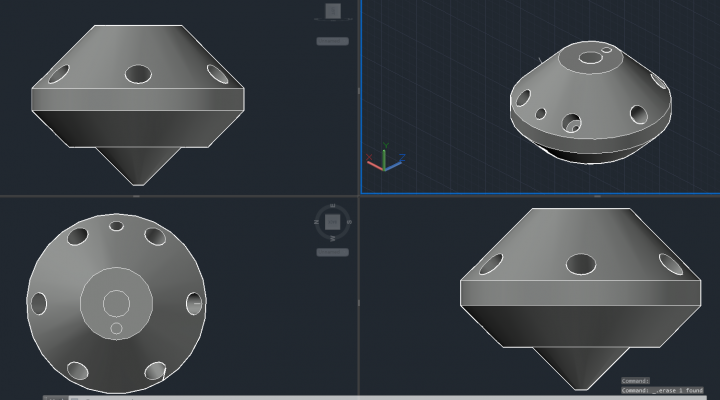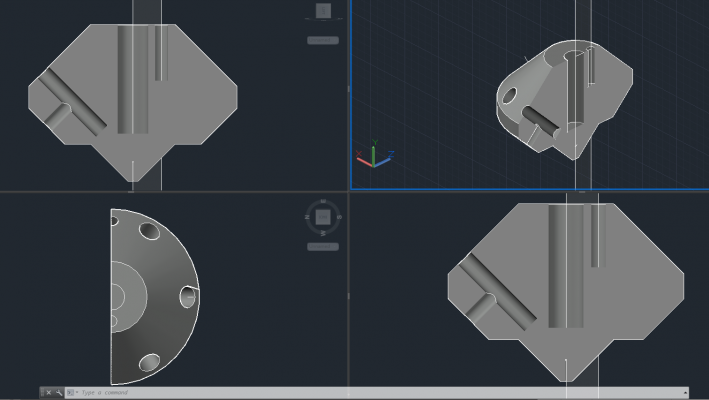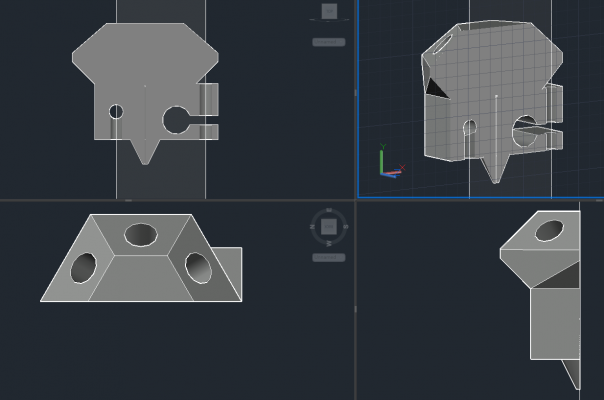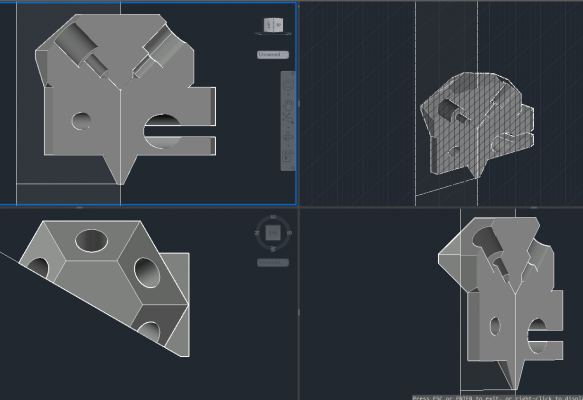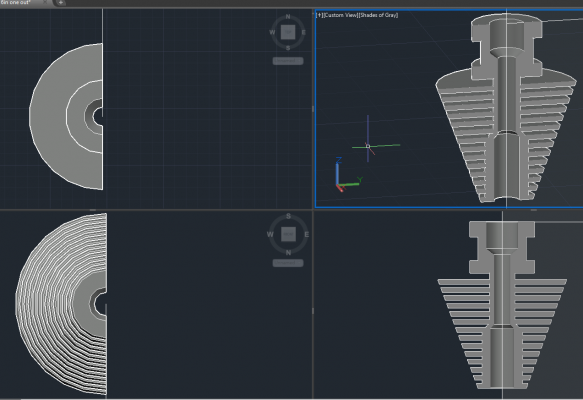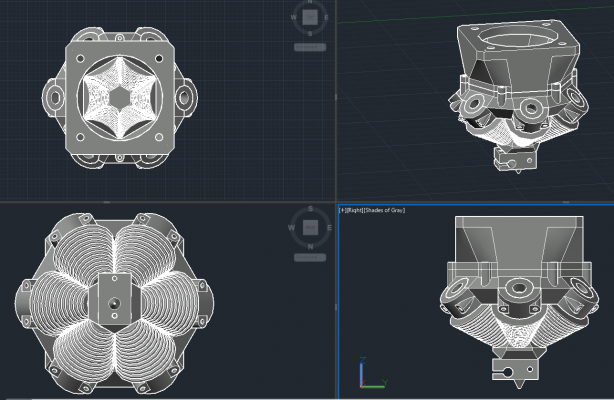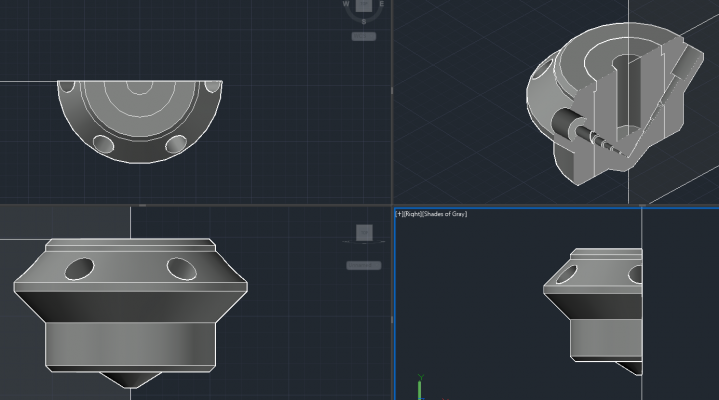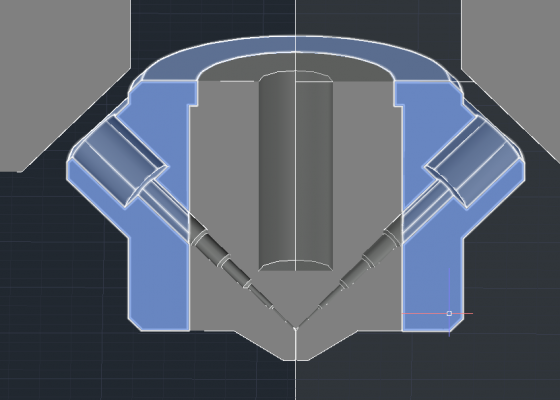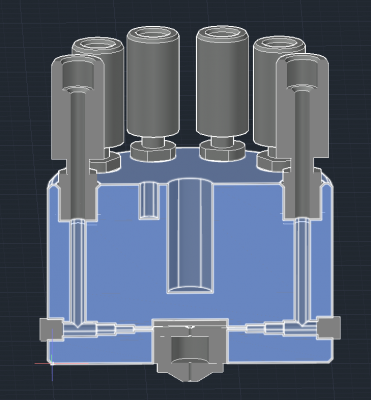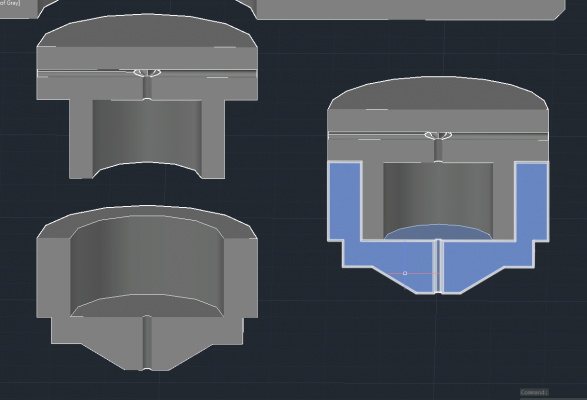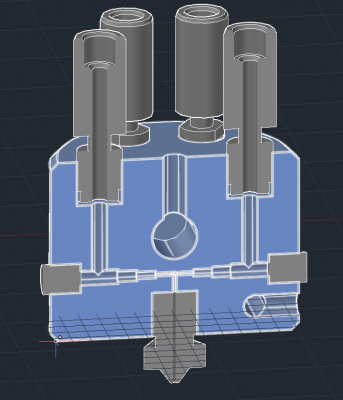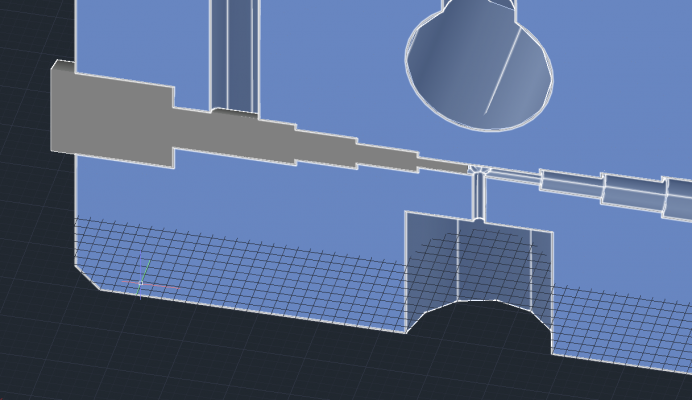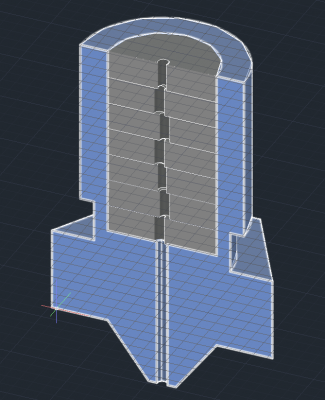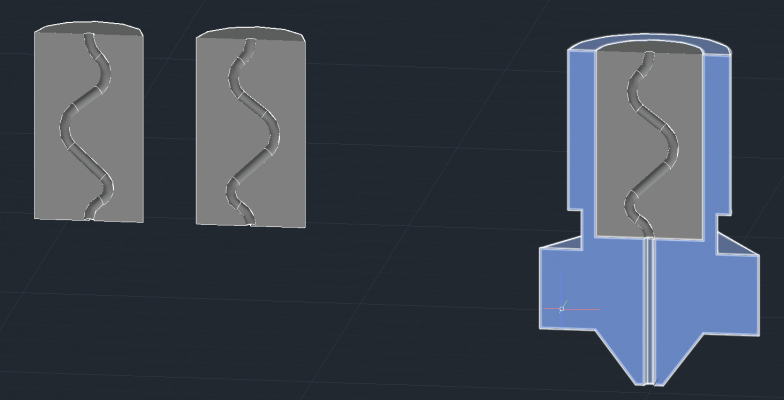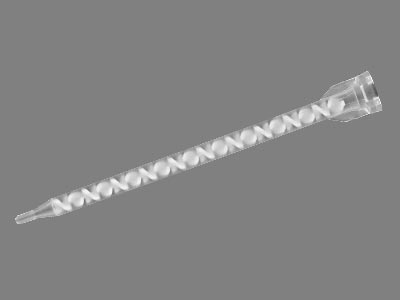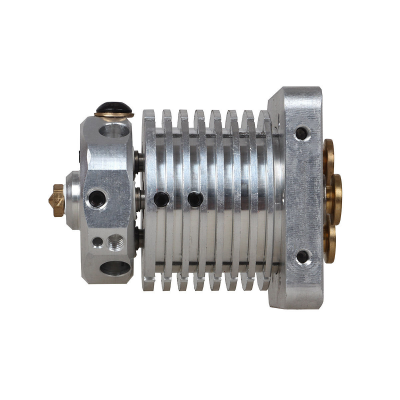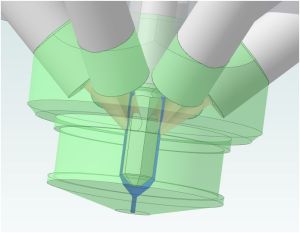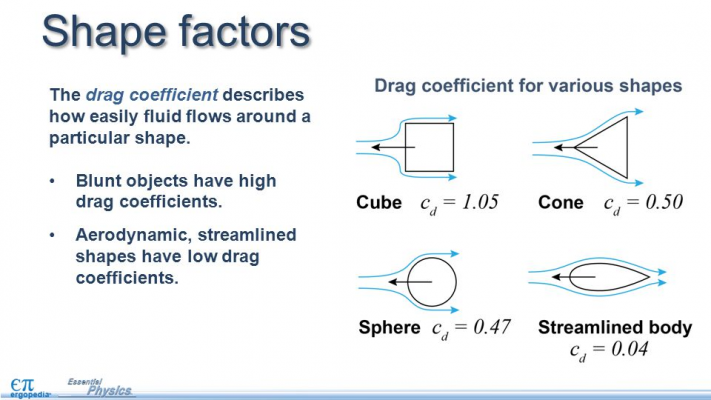Home
>
Developers
>
Topic
6 in 1 out Hot-End development
Posted by sniper567
|
6 in 1 out Hot-End development May 24, 2017 06:33PM |
Registered: 6 years ago Posts: 15 |
I started to develop my own hot end based on the E3D hot end. its intended use was to be able to mix white, black, cyan, magenta, yellow. to allow for any color just like a normal printer does, also I added one more input to allow for a support material. the support material should not be mixed with the colors for its primary purpose is to be dissolved, but there is no reason you can't. (it should be noted that any filament can be fed in).
(all hot ends are designed around a 0.2mm hole size)
so off I went and soon created my first design the V1, it was more or less just a heater block replacement for the E3D hot end.
on the inside 6 tubes would converge to meet in the middle and funnel into a nozzle at the end, one of the drawbacks was this meant much more filament had to be used when changing color or mixing it. but it did have the advantage of using standard M6-1 threaded nozzles and the rest of the E3D hot end kit, meaning only more heatsinks and heat brakes would have to be purchased.
next came the V2. this model addressed many of the flaws of the V1.
the large differences are the shape and the way filaments are mixed, in addition, the V2 was a milled to size, meaning that it was its own nozzle, and no change could be made without making a new one, in terms of switching from a .2 to a .4 meant you would have to break down the hot end and rebuild it to extrude a different size. however, this meant instead of a large mixing area a volume of only 0.16mm^3 would have to be purged to change or mix new colors. the downsides are it was larger and bulkier, with the upside of excellent filament mixing and changing
lastly came the V3, a child of the V1 and the V2, while haveing the externals of the V1 it had the internals of the V2, the only downside to this is that the nozzle is milled to size and can't be changed, but the form factor is smaller and takes less time to heat up.
again it has a similar build to the E3D hot end
a cutaway shows that the V3 has a longer mixing run then the V2 and must clear 0.63mm^3 to change or mix colors.
in the future, I plan to make a version that implements the small channels that are good for mixing but allows for nozzle changes and still maintains the small V1 form factor
also, the heatsinks do have to be modified on the V1 and V3 hot end to fit in a small cluster, however on the V2 they will fit with little to no modification. in addition, they should be made out of pure aluminum, as it dispels heat the fastest and keeps the filament above melt temp.
when it comes to cooling this thing I made a carriage that supports a 60mm fan, due to the large volume of fins on all of the heatsink's, cooling should not be a problem for low to mid-range temp plastics but may need to be modified for high temp plastics.
any ideas for thoughts are greatly appreciated,
please stay tuned to see further updates
please not while this is based on the E3D hot end it is a personal project and will not be sold or mass produced. I am simply looking for ideas for further iterations or hoping my work will spark an idea in someone else. it is in no way meant to infringe on the Intellectual Property agreement E3D has for its products.
Edited 2 time(s). Last edit at 05/24/2017 06:35PM by sniper567.
(all hot ends are designed around a 0.2mm hole size)
so off I went and soon created my first design the V1, it was more or less just a heater block replacement for the E3D hot end.
on the inside 6 tubes would converge to meet in the middle and funnel into a nozzle at the end, one of the drawbacks was this meant much more filament had to be used when changing color or mixing it. but it did have the advantage of using standard M6-1 threaded nozzles and the rest of the E3D hot end kit, meaning only more heatsinks and heat brakes would have to be purchased.
next came the V2. this model addressed many of the flaws of the V1.
the large differences are the shape and the way filaments are mixed, in addition, the V2 was a milled to size, meaning that it was its own nozzle, and no change could be made without making a new one, in terms of switching from a .2 to a .4 meant you would have to break down the hot end and rebuild it to extrude a different size. however, this meant instead of a large mixing area a volume of only 0.16mm^3 would have to be purged to change or mix new colors. the downsides are it was larger and bulkier, with the upside of excellent filament mixing and changing
lastly came the V3, a child of the V1 and the V2, while haveing the externals of the V1 it had the internals of the V2, the only downside to this is that the nozzle is milled to size and can't be changed, but the form factor is smaller and takes less time to heat up.
again it has a similar build to the E3D hot end
a cutaway shows that the V3 has a longer mixing run then the V2 and must clear 0.63mm^3 to change or mix colors.
in the future, I plan to make a version that implements the small channels that are good for mixing but allows for nozzle changes and still maintains the small V1 form factor
also, the heatsinks do have to be modified on the V1 and V3 hot end to fit in a small cluster, however on the V2 they will fit with little to no modification. in addition, they should be made out of pure aluminum, as it dispels heat the fastest and keeps the filament above melt temp.
when it comes to cooling this thing I made a carriage that supports a 60mm fan, due to the large volume of fins on all of the heatsink's, cooling should not be a problem for low to mid-range temp plastics but may need to be modified for high temp plastics.
any ideas for thoughts are greatly appreciated,
please stay tuned to see further updates
please not while this is based on the E3D hot end it is a personal project and will not be sold or mass produced. I am simply looking for ideas for further iterations or hoping my work will spark an idea in someone else. it is in no way meant to infringe on the Intellectual Property agreement E3D has for its products.
Edited 2 time(s). Last edit at 05/24/2017 06:35PM by sniper567.
|
Re: 6 in 1 out Hot-End development May 25, 2017 02:15AM |
Registered: 8 years ago Posts: 5,232 |
Excellent work so far!
I have some experience with the diamond hotend and IMHO the replaceable nozzle is a must for next_gen mixing hotends. ( a clogged hotend is a nightmare without removable nozzle )
I'd also go for watercooled heatsinks. The shape of your heatsinks is a bit counterproductive, since the fins are the shortest, where the heat is the most.
That would drag the heat up and increases the risk of softening filament before it enters the melting zone.
Why not try to use the melting block design of E3D and let water flow through the heater element channel? Just clamp in a 6mm OD brass tubing.
Aargh, I can't wait to get my CNC mill up and running
Edited 2 time(s). Last edit at 05/25/2017 02:17AM by o_lampe.
I have some experience with the diamond hotend and IMHO the replaceable nozzle is a must for next_gen mixing hotends. ( a clogged hotend is a nightmare without removable nozzle )
I'd also go for watercooled heatsinks. The shape of your heatsinks is a bit counterproductive, since the fins are the shortest, where the heat is the most.
That would drag the heat up and increases the risk of softening filament before it enters the melting zone.
Why not try to use the melting block design of E3D and let water flow through the heater element channel? Just clamp in a 6mm OD brass tubing.
Aargh, I can't wait to get my CNC mill up and running

Edited 2 time(s). Last edit at 05/25/2017 02:17AM by o_lampe.
|
Re: 6 in 1 out Hot-End development May 25, 2017 04:16AM |
Admin Registered: 16 years ago Posts: 13,884 |
... you should redesign the bores to reduce the thinnest nozzle-bore lengths.
The longer, the more force you'll need to push it through, and the more "swell" will you receive, after the plastic leaves the nozzle ...
Viktor
--------
Aufruf zum Projekt "Müll-freie Meere" - [reprap.org] -- Deutsche Facebook-Gruppe - [www.facebook.com]
Call for the project "garbage-free seas" - [reprap.org]
The longer, the more force you'll need to push it through, and the more "swell" will you receive, after the plastic leaves the nozzle ...
Viktor
--------
Aufruf zum Projekt "Müll-freie Meere" - [reprap.org] -- Deutsche Facebook-Gruppe - [www.facebook.com]
Call for the project "garbage-free seas" - [reprap.org]
|
Re: 6 in 1 out Hot-End development May 25, 2017 01:37PM |
Registered: 6 years ago Posts: 15 |
thanks, VDX & o_lampe, you both make great points
I definitely will take that into consideration
and in regards to o_lampe's idea about water cooling, I did design a water cooled heat sink but I run into the same issue where the heatsinks where to close together and I had to give them a cone shape, this reduced the volume of water that could get close to the end where the heat propagated from. the issue is, the further I move the heatsinks away the bulkier the head gets, but the more cooling I can do.
thanks for the ideas keep them coming!
after a few hours of design and tinkering, I have finished the V4 with this
this hot end has two improvements, first being it is "nozzle capable" and should push throw filament much better.
when I say it is "nozzle capable" i designed it to be interchangeable but for thermodynamic reasons, the nozzle also has the heater and thermometer in it, and is removed as one piece, meaning for each nozzle you wish to have a separate heater and thermometer must be installed in the block for fast switching.
also, the way the filament channel is constructed there should be minimal resistance
lastly, the metals that the "nozzle" and the main body are made of should be the same metal or the nozzle metal should have a higher thermal expansion to help hold the nozzle in place,
in addition, there are holes that you do not see in the cutaway model but there are places for the thermometer and a screw to hold down the heater and the thermomitor, as well as an M3 hole to securely fasten the nozzle into the body.
Edited 2 time(s). Last edit at 05/25/2017 06:46PM by sniper567.
I definitely will take that into consideration
and in regards to o_lampe's idea about water cooling, I did design a water cooled heat sink but I run into the same issue where the heatsinks where to close together and I had to give them a cone shape, this reduced the volume of water that could get close to the end where the heat propagated from. the issue is, the further I move the heatsinks away the bulkier the head gets, but the more cooling I can do.
thanks for the ideas keep them coming!
after a few hours of design and tinkering, I have finished the V4 with this
this hot end has two improvements, first being it is "nozzle capable" and should push throw filament much better.
when I say it is "nozzle capable" i designed it to be interchangeable but for thermodynamic reasons, the nozzle also has the heater and thermometer in it, and is removed as one piece, meaning for each nozzle you wish to have a separate heater and thermometer must be installed in the block for fast switching.
also, the way the filament channel is constructed there should be minimal resistance
lastly, the metals that the "nozzle" and the main body are made of should be the same metal or the nozzle metal should have a higher thermal expansion to help hold the nozzle in place,
in addition, there are holes that you do not see in the cutaway model but there are places for the thermometer and a screw to hold down the heater and the thermomitor, as well as an M3 hole to securely fasten the nozzle into the body.
Edited 2 time(s). Last edit at 05/25/2017 06:46PM by sniper567.
|
Re: 6 in 1 out Hot-End development May 26, 2017 12:10AM |
Registered: 7 years ago Posts: 12 |
Quote
sniper567
...please not while this is based on the E3D hot end...
more like RepRap.me DIAMOND FULLCOLOR HOTEND
|
Re: 6 in 1 out Hot-End development May 26, 2017 02:38AM |
Registered: 6 years ago Posts: 15 |
in response to rolloo
thank you for posting this picture, I have seen the diamond hot end with 3 inputs but never with five, it will definitely be helpful further on as people use it and find the benefits and the drawbacks.
the V1 and V3 was based on the E3D hot end and the V2 and V4 while they do resemble the diamond hot end, they were designed independently, in terms of creating a nozzle while the V1 and V3 would work they would be difficult and costly to manufacture, while the V4 is designed to be manufactured using a lathe and a drill press. it seems that if trying to add 6 or more filaments a circular shape resembling a V2 or V4 and the diamond hot end series is the result. I even tried to make a 32 filament input hot end for fun but while in theory, it worked it was ridiculously large. in conclusion it's likely that any hot end in the future that has more than 3 input will be a circular shape.
interestingly it exhibits the same problems that the V1 V3 and V4 have, they all require a modified heatsink to fit, it would be interesting to see if the diamond hot end will come down in price and if it will be expanded to 6 or 7 inputs? or if they will ever make a nozzle version?
this has given me a bunch to consider so thank you rollo ill definitely use this as an aid in further iterations of my designs.
thank you for posting this picture, I have seen the diamond hot end with 3 inputs but never with five, it will definitely be helpful further on as people use it and find the benefits and the drawbacks.
the V1 and V3 was based on the E3D hot end and the V2 and V4 while they do resemble the diamond hot end, they were designed independently, in terms of creating a nozzle while the V1 and V3 would work they would be difficult and costly to manufacture, while the V4 is designed to be manufactured using a lathe and a drill press. it seems that if trying to add 6 or more filaments a circular shape resembling a V2 or V4 and the diamond hot end series is the result. I even tried to make a 32 filament input hot end for fun but while in theory, it worked it was ridiculously large. in conclusion it's likely that any hot end in the future that has more than 3 input will be a circular shape.
interestingly it exhibits the same problems that the V1 V3 and V4 have, they all require a modified heatsink to fit, it would be interesting to see if the diamond hot end will come down in price and if it will be expanded to 6 or 7 inputs? or if they will ever make a nozzle version?
this has given me a bunch to consider so thank you rollo ill definitely use this as an aid in further iterations of my designs.
|
Re: 6 in 1 out Hot-End development May 26, 2017 02:54PM |
Registered: 8 years ago Posts: 622 |
As a long time user of the Diamond, here are a few points to consider.
Firstly, the Diamond is actually very bad at mixing. What comes out of the nozzle tip is akin to stripey toothpaste. I'm not seeing anything in your design that would be any better in this respect. Ideally, there needs to be some sort of stirring action to mix the filaments.
IMO a replaceable nozzle is a must. I've recently had to replace one of mine because basically, it was worn out. The hole at the tip was more triangular shaped than circular and enlarged from it's original 0.4mm such that a 0.8mm diameter drill be could be inserted. This nozzle had never been used for anything other than PLA, PETG and PETT so nothing abrasive but it had done many hundreds of hours - perhaps thousands. The brass part itself isn't particularly costly but replacing it is a fairly major strip down and rebuild.
Personally, I think you need 6 inputs for colour mixing - (which you have but you mentioned only 5 would be needed). My thoughts are that you need CYMK like an inkjet printer but also white because we don't have a white background. That'll take care of the Hue, but I think we also need transparent filament to take care of the Saturation. I believe on an inkjet, this would be taken care of by varying the dot density but we can't do that (as it would mean having holes in the printed part) so mixing with transparent filament would achieve the same effect.
Another problem with the Diamond, and also with your design (hope you don't mind me saying so) is that by using "off the shelf" heat sinks, they have to be angled outwards. In the case of the Diamond, they are angled out at 27 degrees. This means that the top of the heat sinks just about fit inside a circle of 70mm diameter. That's without any extruders. It is normal to use Bowden tubes with the Diamond so you need to allow another few millimetres either side and realistically, you end with a hot end that takes up 100mm in X and in Y. So in my opinion, a better design would use a (single) bespoke heat sink such that the filament path could be much closer to the vertical which would then mean a much smaller footprint and regain some of the lost X and Y travel. With any sort of direct drive, whether that be a conventional extruder of one of the cable driven designs, the footprint becomes even greater which loses even more travel.
I appreciate that this is just an exercise but even if you only end up making one for your own use, you should consider the extra costs. For the reasons outlined above, you need a big printer frame. To build a big frame that's rigid doesn't come cheap. More importantly though is that you need to feed the beast and for that you'll need 6 extruders. I use E3D Titans but at £45+postage +VAT they work out at about £60 so my three cost me about £180, six is going to cost a whopping £360 and that's without motors so realistically, it's going to be in the order of £400 on top of the cost of the hot end itself.
Then of course, you have to keep all 6 inputs fed with filament at all times - that's 6 rolls that you'll have to accommodate (as well as the 6 extruders).
So in summary, if you want to improve on the Diamond design, make a replaceable nozzle, use a bespoke heat sink with more vertical filament path to reduce the overall size and if you can, figure out some way to actually mix the filaments. Forget about what it will cost - anyone who can afford 6 extruders and a big enough printer to accommodate it all, will be able to pay the price of the hot end. Just my twopence worth........
[somei3deas.wordpress.com]
[www.youtube.com]
Firstly, the Diamond is actually very bad at mixing. What comes out of the nozzle tip is akin to stripey toothpaste. I'm not seeing anything in your design that would be any better in this respect. Ideally, there needs to be some sort of stirring action to mix the filaments.
IMO a replaceable nozzle is a must. I've recently had to replace one of mine because basically, it was worn out. The hole at the tip was more triangular shaped than circular and enlarged from it's original 0.4mm such that a 0.8mm diameter drill be could be inserted. This nozzle had never been used for anything other than PLA, PETG and PETT so nothing abrasive but it had done many hundreds of hours - perhaps thousands. The brass part itself isn't particularly costly but replacing it is a fairly major strip down and rebuild.
Personally, I think you need 6 inputs for colour mixing - (which you have but you mentioned only 5 would be needed). My thoughts are that you need CYMK like an inkjet printer but also white because we don't have a white background. That'll take care of the Hue, but I think we also need transparent filament to take care of the Saturation. I believe on an inkjet, this would be taken care of by varying the dot density but we can't do that (as it would mean having holes in the printed part) so mixing with transparent filament would achieve the same effect.
Another problem with the Diamond, and also with your design (hope you don't mind me saying so) is that by using "off the shelf" heat sinks, they have to be angled outwards. In the case of the Diamond, they are angled out at 27 degrees. This means that the top of the heat sinks just about fit inside a circle of 70mm diameter. That's without any extruders. It is normal to use Bowden tubes with the Diamond so you need to allow another few millimetres either side and realistically, you end with a hot end that takes up 100mm in X and in Y. So in my opinion, a better design would use a (single) bespoke heat sink such that the filament path could be much closer to the vertical which would then mean a much smaller footprint and regain some of the lost X and Y travel. With any sort of direct drive, whether that be a conventional extruder of one of the cable driven designs, the footprint becomes even greater which loses even more travel.
I appreciate that this is just an exercise but even if you only end up making one for your own use, you should consider the extra costs. For the reasons outlined above, you need a big printer frame. To build a big frame that's rigid doesn't come cheap. More importantly though is that you need to feed the beast and for that you'll need 6 extruders. I use E3D Titans but at £45+postage +VAT they work out at about £60 so my three cost me about £180, six is going to cost a whopping £360 and that's without motors so realistically, it's going to be in the order of £400 on top of the cost of the hot end itself.
Then of course, you have to keep all 6 inputs fed with filament at all times - that's 6 rolls that you'll have to accommodate (as well as the 6 extruders).
So in summary, if you want to improve on the Diamond design, make a replaceable nozzle, use a bespoke heat sink with more vertical filament path to reduce the overall size and if you can, figure out some way to actually mix the filaments. Forget about what it will cost - anyone who can afford 6 extruders and a big enough printer to accommodate it all, will be able to pay the price of the hot end. Just my twopence worth........
[somei3deas.wordpress.com]
[www.youtube.com]
|
Re: 6 in 1 out Hot-End development May 26, 2017 06:19PM |
Registered: 6 years ago Posts: 15 |
Thanks deckingman
You make a lot of good points, while, in theory, you only need 5 to print full color I have designed the V1 to V4 to accommodate 6 filaments, this means all the colors and a dissolvable filament
Also, it was my understanding that I only need cyan yellow magenta black and white to make a full-color spectrum?
Also, you hit on some points that I had thought off and given me more ideas so thank you, and don't worry anything that you see that can be improved I'd love to hear about it. I'd rather be told I'm wrong then not being told at all, so keep those ideas coming.
Based on what you said I have a few things I'd like to implement in the next design,
1. An actual mixing element that would visible make the filaments mix more homogeneously, I have seen hot end that use a small stepper motor to mix the filaments but I should prefer to have a solid mixer, otherwise, I believe changing the nozzle would become too difficult.
2. A way to plug hole that is not being used ( possibly a spiral screw )
3. Also, I have been looking into making a hot end that would funnel filament straight down at a 90 degree angle and then turn 45 degrees to mix and then be extruded, I'm still researching how this might be machined or made, but I hope to get the overall diameter down so smaller machines can use it
4. While I agree the cost is not so much an issue in the RND stage, I do hope I can get it down, that way it does not deter other people from trying something similar, I personally have chunks of metal lying around and a good shop so it's not difficult to fabricate the things I design, but my hope is that other people are able to make what they want.
Also, your idea of mixing transparent filliment with colored Filaments is interesting, I do believe I should be able to change the saturation by simply adding more white, however, a clear filament does offer an interesting possibility by allowing you to mix clear or semi-opaque colors in addition to the solid white. I will do a test to see is it is possible if it does I will definitely add a slot for a clear filament to the design.
I will post these pictures later
Keep the good ideas coming
Edited 5 time(s). Last edit at 05/26/2017 11:49PM by sniper567.
You make a lot of good points, while, in theory, you only need 5 to print full color I have designed the V1 to V4 to accommodate 6 filaments, this means all the colors and a dissolvable filament
Also, it was my understanding that I only need cyan yellow magenta black and white to make a full-color spectrum?
Also, you hit on some points that I had thought off and given me more ideas so thank you, and don't worry anything that you see that can be improved I'd love to hear about it. I'd rather be told I'm wrong then not being told at all, so keep those ideas coming.
Based on what you said I have a few things I'd like to implement in the next design,
1. An actual mixing element that would visible make the filaments mix more homogeneously, I have seen hot end that use a small stepper motor to mix the filaments but I should prefer to have a solid mixer, otherwise, I believe changing the nozzle would become too difficult.
2. A way to plug hole that is not being used ( possibly a spiral screw )
3. Also, I have been looking into making a hot end that would funnel filament straight down at a 90 degree angle and then turn 45 degrees to mix and then be extruded, I'm still researching how this might be machined or made, but I hope to get the overall diameter down so smaller machines can use it
4. While I agree the cost is not so much an issue in the RND stage, I do hope I can get it down, that way it does not deter other people from trying something similar, I personally have chunks of metal lying around and a good shop so it's not difficult to fabricate the things I design, but my hope is that other people are able to make what they want.
Also, your idea of mixing transparent filliment with colored Filaments is interesting, I do believe I should be able to change the saturation by simply adding more white, however, a clear filament does offer an interesting possibility by allowing you to mix clear or semi-opaque colors in addition to the solid white. I will do a test to see is it is possible if it does I will definitely add a slot for a clear filament to the design.
I will post these pictures later
Keep the good ideas coming
Edited 5 time(s). Last edit at 05/26/2017 11:49PM by sniper567.
|
Re: 6 in 1 out Hot-End development May 26, 2017 07:46PM |
Registered: 9 years ago Posts: 978 |
A couple of thoughts regarding deckingman's ideas and yourr response:
One big heatsink for 6 filaments is going to be awkward to design and fit if the heatbreaks aren't vertical. OTOH, If the heatbreaks are vertical, then it will take less space anyway. Vertical heatbreaks leads to some complexity in the filament path inside the brass heater-block, ideally curved paths from vertical at the heatbreak down to perhaps 45 degrees at the mixing chamber. A sandwich of 2 brass parts clamped together perhaps? The top part has vertical heat break mounts, bottom part has sloping feed paths down to the mixing chamber. You could even have 3 or 4 slices with gradually changing slope angles. This would require some precision manufacturing and assembly though. Soooo... have you investigated fabricating the heater-block by metal 3D printing (e.g. sintered titanium)? I don't know how expensive that would be, but maybe OK for testing prototypes? Another thought... curved brass tubes inside an oil-filled heated chamber?
The assymetric heater cartridge in the V1 design seems to me to be a likely weak point... some of the filament feeds will be hotter than others. I prefer the solution with the heater cartridge in the middle of the block. In any case, you should probably use thermal insulation around the outside of the heater block to help keep the temperature uniform?
To reduce the Diamond "toothpaste-stripe" mixing problem, perhaps use a helical mixing chamber? Or outlet/nozzle? That might be more achievable with a 3D-printed heater-block. But perhaps using a cyclical small retract/extrude drive pattern on all the filaments would improve the mixing?
I agree that 6 colours is probably minimal... CYMK, white, transparent. Mixing in white will make the output more pastel, not more transparent. So design for 7 (or 8?) filaments to allow for supports and other stuff (flexible filament, temperature dependent colour-changing filament, glow-in-the-dark filament).
Plugging a hole that isn't being used is surely a non-issue? Just leave some filament in there.
Probably there's going to have to be a whole new controller/interface board designed too? Arduino won't be fast enough, and I don't think there's anything RAMPS-like that can support 9+ stepper motors. Is there any firmware that supports 9+ steppers?
One big heatsink for 6 filaments is going to be awkward to design and fit if the heatbreaks aren't vertical. OTOH, If the heatbreaks are vertical, then it will take less space anyway. Vertical heatbreaks leads to some complexity in the filament path inside the brass heater-block, ideally curved paths from vertical at the heatbreak down to perhaps 45 degrees at the mixing chamber. A sandwich of 2 brass parts clamped together perhaps? The top part has vertical heat break mounts, bottom part has sloping feed paths down to the mixing chamber. You could even have 3 or 4 slices with gradually changing slope angles. This would require some precision manufacturing and assembly though. Soooo... have you investigated fabricating the heater-block by metal 3D printing (e.g. sintered titanium)? I don't know how expensive that would be, but maybe OK for testing prototypes? Another thought... curved brass tubes inside an oil-filled heated chamber?
The assymetric heater cartridge in the V1 design seems to me to be a likely weak point... some of the filament feeds will be hotter than others. I prefer the solution with the heater cartridge in the middle of the block. In any case, you should probably use thermal insulation around the outside of the heater block to help keep the temperature uniform?
To reduce the Diamond "toothpaste-stripe" mixing problem, perhaps use a helical mixing chamber? Or outlet/nozzle? That might be more achievable with a 3D-printed heater-block. But perhaps using a cyclical small retract/extrude drive pattern on all the filaments would improve the mixing?
I agree that 6 colours is probably minimal... CYMK, white, transparent. Mixing in white will make the output more pastel, not more transparent. So design for 7 (or 8?) filaments to allow for supports and other stuff (flexible filament, temperature dependent colour-changing filament, glow-in-the-dark filament).
Plugging a hole that isn't being used is surely a non-issue? Just leave some filament in there.
Probably there's going to have to be a whole new controller/interface board designed too? Arduino won't be fast enough, and I don't think there's anything RAMPS-like that can support 9+ stepper motors. Is there any firmware that supports 9+ steppers?
|
Re: 6 in 1 out Hot-End development May 26, 2017 08:33PM |
Registered: 6 years ago Posts: 15 |
Thanks for the input frankvdh
You make some good points
In regards to you question about the electrics, I have a ramps 1.4 that I am currently using as a test bed, using a CNC shield I was able to get 6 filament extruders with little modifications, I'm looking into if I can chain another board to add 4 more stepper drivers or if there is a larger CNC board I can use.
And the issue with plugging a hole is unless the filament is under pressure I have seen melted plastic push out plugs of filament if they were not being held by a stepper or a clamp.
now this V5 is just a rough draft I wanted to get out of my head before I turn in for then night
NOTE: it is a monstrously large hot end I will work on getting it smaller. just for fun, I designed it with 10 inputs but of corse, it can be reduced down to less.
I designed this one using the Cyclopes heat brakes with the idea that I can design a water cooled jacket or fin assembly to slip over them and thus solve the cooling problem. also, you'll notice it has a sharp 90-degree turn that the plastic has to make but I have used a cyclopes hot end before and found they do work so it should not be a problem but testing will determine if that is true or not. it should be noted that the small prongs you see sticking out the side are M4 set screws that simply fill in the hole.
lastly, you'll notice the nozzle,
while I did not draw the threading the top piece slips into the bottom and as a single piece is inserted into the hot end, you will notice a small gap between the top and the bottom, I plan to make this a mixing chamber,
the first idea is to use plates with off centered holes, this should push the plastic back and forth to mix it.
the second idea was to have two halves of a cylinder and CNC a sin wave or something and then press them together to create the channel, I will test both idea to see which one works the best or if I need a plan C.
keep those ideas coming!
Edited 1 time(s). Last edit at 05/27/2017 12:07AM by sniper567.
You make some good points
In regards to you question about the electrics, I have a ramps 1.4 that I am currently using as a test bed, using a CNC shield I was able to get 6 filament extruders with little modifications, I'm looking into if I can chain another board to add 4 more stepper drivers or if there is a larger CNC board I can use.
And the issue with plugging a hole is unless the filament is under pressure I have seen melted plastic push out plugs of filament if they were not being held by a stepper or a clamp.
now this V5 is just a rough draft I wanted to get out of my head before I turn in for then night
NOTE: it is a monstrously large hot end I will work on getting it smaller. just for fun, I designed it with 10 inputs but of corse, it can be reduced down to less.
I designed this one using the Cyclopes heat brakes with the idea that I can design a water cooled jacket or fin assembly to slip over them and thus solve the cooling problem. also, you'll notice it has a sharp 90-degree turn that the plastic has to make but I have used a cyclopes hot end before and found they do work so it should not be a problem but testing will determine if that is true or not. it should be noted that the small prongs you see sticking out the side are M4 set screws that simply fill in the hole.
lastly, you'll notice the nozzle,
while I did not draw the threading the top piece slips into the bottom and as a single piece is inserted into the hot end, you will notice a small gap between the top and the bottom, I plan to make this a mixing chamber,
the first idea is to use plates with off centered holes, this should push the plastic back and forth to mix it.
the second idea was to have two halves of a cylinder and CNC a sin wave or something and then press them together to create the channel, I will test both idea to see which one works the best or if I need a plan C.
keep those ideas coming!
Edited 1 time(s). Last edit at 05/27/2017 12:07AM by sniper567.
|
Re: 6 in 1 out Hot-End development May 27, 2017 02:28AM |
Registered: 8 years ago Posts: 1,671 |
|
Re: 6 in 1 out Hot-End development May 27, 2017 10:44AM |
Registered: 8 years ago Posts: 622 |
Quote
frankvdh
..............................Plugging a hole that isn't being used is surely a non-issue? Just leave some filament in there.
Actually, IMO it's not a bad idea to have unused inputs plugged. I used to just leave filament in my diamond when only printing a single colour but there are two issues. Firstly you need to retract and un-retract all filaments simultaneously otherwise all that happens is that filament is drawn from an unused input, rather than the nozzle tip and it's like printing with no retraction at all. With Duet electronics, this is accomplished by using firmware retraction. The issue is that the "unused" filament gets ground away by the hobbed bolt constantly retracting and un-retracting the same few millimetres, so eventually, it stops being moved and you end up with effectively no retraction. The other issue is that the filament gets cooked by being kept at a high temperature but not moving. When it comes to using that input again, the first thing you get (at least with PLA) is a load of what looks like steam or vapour followed by a very runny goo until some good stuff comes through. The way I get round it when printing a single filament is to load the main reel into one input but pull off a couple of lengths of few metres and load these into the "unused" inputs. Then, with a tool defined to use all 3 extruders, I set the mixing ratio to 0.98:0.01:0.01 so effectively using 98% of the main reel and 1% of the other two. This ensures that the "unused" inputs are kept moving, albeit very slightly but it's enough to prevent the two issues detailed above.
Ref stepper motor hardware and firmware. Duet (WiFi or Ethernet) will give you 5 plus Duex5 will give you another 5 making 10 in total. Assuming one for Z, and one each X and Y that leaves two for extruders on the Duet main Board. I use the Duex5 but currently only need one of the 5 available to give me three extruders so in theory, I could add another 4 making 7 colours/filaments in total.
Ian
[somei3deas.wordpress.com]
[www.youtube.com]
|
Re: 6 in 1 out Hot-End development May 27, 2017 08:16PM |
Registered: 7 years ago Posts: 558 |
I think the other aspect that everyone is overlooking. Your assuming you can take a little of one color and a little of a different color and make them mix. Sadly, I believe the current formulation of ABS or PLA or even Nylon does not work like this and you'll always end up with striped toothpaste look no matter what mixing chamber you use. For your mixing chamber to work I think you'd need completely different plastic compositions.
I could be wrong but in my experience with industrial plastic extrusion if your extruding say red and you add one blue pellet to make purple you end up with red and a thin blue stripe before you ever see purple. And those Industrial extruder have an internal rotating screw that feeds the plastic out. All of the ones I've worked with extrude natural color with the odd color pellet mixed in say in a 1000:1 ratio.
I think what your trying is a good idea, but you might want to step back and see if you can even mix plastic colors to make new colors. For what I understand, Ink jet and laser printers do this by layering different colors on top of each other in different quantities to create all the colors, but that's not going to to work very well with a 3D object. It might not be a bad idea to see how that sand caste printing does multi color as that's full color 3D objects.
I could be wrong but in my experience with industrial plastic extrusion if your extruding say red and you add one blue pellet to make purple you end up with red and a thin blue stripe before you ever see purple. And those Industrial extruder have an internal rotating screw that feeds the plastic out. All of the ones I've worked with extrude natural color with the odd color pellet mixed in say in a 1000:1 ratio.
I think what your trying is a good idea, but you might want to step back and see if you can even mix plastic colors to make new colors. For what I understand, Ink jet and laser printers do this by layering different colors on top of each other in different quantities to create all the colors, but that's not going to to work very well with a 3D object. It might not be a bad idea to see how that sand caste printing does multi color as that's full color 3D objects.
|
Re: 6 in 1 out Hot-End development May 27, 2017 10:01PM |
Registered: 6 years ago Posts: 15 |
thanks PDBeal
you make a good point. however, the scale that we are working with is much smaller than that of industrial scale. consider this.when you look at the screen that you are reading from right now, all you see is a picture, but if you look using a magnifying glass you will notice that it is just a combination of 3 very separate colors, I agree with you that if you want purple the best way to get it is put in a purple filament, but for the purposes of 3d printing if we can get the "toothpaste look" small enuff it will blend like the pixels on your screen.
also, I've been hand mixing filaments to test deckingman idea about hue with clear vs white filler, I can say I have successfully created gray from black and white and orange from red and yellow. I would say it takes about only a dozen of passes with a screwdriver before the colors start to mix, and considering the quantity of plastic would be even smaller in the nozzle in believe I can get it to the point where it starts to merge like the pixels on your screen. I think this is a problem of size and quantity and should be achievable.
however, it sounds like you have a fair bit of Knowledge about mixing plastics and I would love to hear more!
Edited 1 time(s). Last edit at 05/27/2017 10:22PM by sniper567.
you make a good point. however, the scale that we are working with is much smaller than that of industrial scale. consider this.when you look at the screen that you are reading from right now, all you see is a picture, but if you look using a magnifying glass you will notice that it is just a combination of 3 very separate colors, I agree with you that if you want purple the best way to get it is put in a purple filament, but for the purposes of 3d printing if we can get the "toothpaste look" small enuff it will blend like the pixels on your screen.
also, I've been hand mixing filaments to test deckingman idea about hue with clear vs white filler, I can say I have successfully created gray from black and white and orange from red and yellow. I would say it takes about only a dozen of passes with a screwdriver before the colors start to mix, and considering the quantity of plastic would be even smaller in the nozzle in believe I can get it to the point where it starts to merge like the pixels on your screen. I think this is a problem of size and quantity and should be achievable.
however, it sounds like you have a fair bit of Knowledge about mixing plastics and I would love to hear more!
Edited 1 time(s). Last edit at 05/27/2017 10:22PM by sniper567.
|
Re: 6 in 1 out Hot-End development May 28, 2017 04:26AM |
Registered: 8 years ago Posts: 622 |
As I said in one of my earlier posts, the stripey toothpaste effect is very real, as PDBeal has reiterated. If you set mixing ratios of 33% for each of the 3 filaments (using a Diamond hot end) then print a 3 sided object with each face orientated towards one of the filament inputs, you end up with each face a different colour. I did a bit of a write up on my blog which is in my signature - take a look as there is some other stuff related to mixing hot ends that might be of interest to you. The stripey toothpaste effect can be mitigated to a large extent by using translucent filaments.
[somei3deas.wordpress.com]
[www.youtube.com]
[somei3deas.wordpress.com]
[www.youtube.com]
|
Re: 6 in 1 out Hot-End development May 28, 2017 11:04AM |
Registered: 8 years ago Posts: 5,232 |
Quote
PBDeal
...and those Industrial extruder have an internal rotating screw that feeds the plastic out.
That's the point: the screw pushes the plastic out, but to mix the different colors, you would want the screw to pull the filament back into the mixing chamber and partially work against extruder pressure. That way, they mix up much better.
@deckingman
Did you try to use a different mix_ratio tool for infill? That way you could also get rid of the unused filament when printing single color.
|
Re: 6 in 1 out Hot-End development May 28, 2017 03:12PM |
Registered: 9 years ago Posts: 978 |
Right... so the screw needs to turn at a faster rate than the filament flow rate, with room around the outside of the screw for filament to flow back. Perhaps the ultimate would be a paddle wheel which just rotates the molten filament in the mixing chamber and doesn't push it out at all.
|
Re: 6 in 1 out Hot-End development May 28, 2017 03:18PM |
Registered: 8 years ago Posts: 622 |
Quote
frankvdh
Right... so the screw needs to turn at a faster rate than the filament flow rate, with room around the outside of the screw for filament to flow back. Perhaps the ultimate would be a paddle wheel which just rotates the molten filament in the mixing chamber and doesn't push it out at all.
Yes, I do believe that's how the guy who posts on these forums (can't remember his name) is doing it with his active mixing hot end. Something similar to that anyway.
|
Re: 6 in 1 out Hot-End development May 28, 2017 03:47PM |
Registered: 6 years ago Posts: 15 |
I believe his name is darenschwenke
.Arcus3D M2 - Six material, active mixing linear delta 3d printer
I have been following his work and even attempted to make one of my own, but ran into the problem that he stated, it was difficult to get the tolerances tight enuff where I could reliably not have leaking.
that's why I wanted to make one that did not require an external motor.
Edited 2 time(s). Last edit at 05/28/2017 03:53PM by sniper567.
.Arcus3D M2 - Six material, active mixing linear delta 3d printer
I have been following his work and even attempted to make one of my own, but ran into the problem that he stated, it was difficult to get the tolerances tight enuff where I could reliably not have leaking.
that's why I wanted to make one that did not require an external motor.
Edited 2 time(s). Last edit at 05/28/2017 03:53PM by sniper567.
|
Re: 6 in 1 out Hot-End development May 28, 2017 05:28PM |
Registered: 9 years ago Posts: 978 |
I guess my idea of a helical mixing/chamber/outlet is the opposite extreme of the "mixing screw"... the "screw" doesn't move at all; just the filament moves relative to it.
Perhaps we need someone with a knowledge of fluid dynamics/hydraulics on how to maximise the turbulence in the flow of the viscous, incompressible filament (Stokes flow)? I guess that minimising friction (to minimise force applied by steppers) would be another, secondary, concern.
Perhaps we need someone with a knowledge of fluid dynamics/hydraulics on how to maximise the turbulence in the flow of the viscous, incompressible filament (Stokes flow)? I guess that minimising friction (to minimise force applied by steppers) would be another, secondary, concern.
|
Re: 6 in 1 out Hot-End development May 28, 2017 07:08PM |
Registered: 6 years ago Posts: 15 |
so the V6 has several modifications versus the V5
first off it still used M4 set screws to close up the holes, this one has six input filaments and uses the cyclops heat brakes with will allow me to make a short water cooling or fin attachment for cooling. also, the design is scalable to accommodate more input but may require a 24v heater.
also, the plug idea was simple to implement and using the same idea as the set pin I can mill a pin that will plug most of the hole when not in use
lastly, I am still testing the validity of static filament mixing but one idea I have is to take a standard nozzle (this way it's familiar and easy to do) and implement the mixing system inside the nozzle.
the one shown above is the stacked disk idea mentioned in a previous post
and in regards to frankvdh idea about fluid dynamics, I agree, the rest of the work is just figgering out how to make everything fit, the most important part is getting the filaments to mix. I have been studying up on fluid dynamics but it's a big subject and I'm just reading textbooks and researching this stuff on my own, someone with prior knowledge would be very useful.
Edited 1 time(s). Last edit at 05/28/2017 07:13PM by sniper567.
first off it still used M4 set screws to close up the holes, this one has six input filaments and uses the cyclops heat brakes with will allow me to make a short water cooling or fin attachment for cooling. also, the design is scalable to accommodate more input but may require a 24v heater.
also, the plug idea was simple to implement and using the same idea as the set pin I can mill a pin that will plug most of the hole when not in use
lastly, I am still testing the validity of static filament mixing but one idea I have is to take a standard nozzle (this way it's familiar and easy to do) and implement the mixing system inside the nozzle.
the one shown above is the stacked disk idea mentioned in a previous post
and in regards to frankvdh idea about fluid dynamics, I agree, the rest of the work is just figgering out how to make everything fit, the most important part is getting the filaments to mix. I have been studying up on fluid dynamics but it's a big subject and I'm just reading textbooks and researching this stuff on my own, someone with prior knowledge would be very useful.
Edited 1 time(s). Last edit at 05/28/2017 07:13PM by sniper567.
|
Re: 6 in 1 out Hot-End development May 29, 2017 01:48AM |
Registered: 8 years ago Posts: 5,232 |
|
Re: 6 in 1 out Hot-End development May 29, 2017 10:28AM |
Registered: 7 years ago Posts: 558 |
Something in the back of my head says, if you mix filaments into a single new color (assuming for the moment that this is even doable), your not going to be able to do any retraction or if you do you won't be able to pull the filament out of the mixing chamber enough to relieve the pressure.
|
Re: 6 in 1 out Hot-End development May 29, 2017 11:48AM |
Registered: 10 years ago Posts: 126 |
retraction is also something I was wondering about. With the nozzle concept getting more complicated with each step the chances for retraction to work seem to decline.
If mixing is necessary maybe it makes more sense to look at the pellet extruder Idea. It might be easier to add teh "full color" feature to an pellet extruder than to go the route of 6 Filament Extruder and a mixer.
But I do mostly software so I might be wrong,...
If mixing is necessary maybe it makes more sense to look at the pellet extruder Idea. It might be easier to add teh "full color" feature to an pellet extruder than to go the route of 6 Filament Extruder and a mixer.
But I do mostly software so I might be wrong,...
|
Re: 6 in 1 out Hot-End development May 29, 2017 03:13PM |
Registered: 8 years ago Posts: 622 |
Ref retraction. At least with the Diamond hot end, what you have to do is retract all 3 filaments simultaneously even if only one is in use, otherwise if you retract a single filament, all that happens is the filament gets drawn from one of the other inputs instead of the nozzle tip.
Maybe another approach might be just to use a single clear, transparent filament then mix dye to the desired colour and add it to the molten filament? So there would be two stages of mixing - one to mix the liquid dye to get the correct colour, then a second stage to mix the dye with the molten filament. If you could somehow coat the inside of a tube with dye, then push the filament through that tube, it would coat the outside of the filament bead so maybe it wouldn't matter is it wasn't mixed all the way through, as long as it was coated all around? Just kind of thinking out loud.............
Maybe another approach might be just to use a single clear, transparent filament then mix dye to the desired colour and add it to the molten filament? So there would be two stages of mixing - one to mix the liquid dye to get the correct colour, then a second stage to mix the dye with the molten filament. If you could somehow coat the inside of a tube with dye, then push the filament through that tube, it would coat the outside of the filament bead so maybe it wouldn't matter is it wasn't mixed all the way through, as long as it was coated all around? Just kind of thinking out loud.............
|
Re: 6 in 1 out Hot-End development May 29, 2017 03:43PM |
Registered: 6 years ago Posts: 15 |
in response to o_lampe, I have thought about retraction as well and I believe it can be helped but not completely gotten rid off, first off a wipe tower would prove beneficial and in addition, the second type of nozzle where instead of taking SLA I can make a similar thing out of good old metal. however the one I designed is simple and probably could be made more complex using other methods, I actually went to a friend who used to be a jeweler, and he showed me how to do jewelry quality lost wax casting which may be very usable in the nozzle design.
I believe that using lost wax casting I can get a very complex but simple static mixing nozzle, and I can use a mix of polishing agent and water pumped throw the chamber to polish the inside, again I'm still researching fluid dynamics to see how to best implement this.
also right now my printer is in pieces, I'm upgrading its frame so, I can get a bigger print area, but what I would like to do is use gear boxes to turn the 400 steps into something like 4000 by using a 10:1 gearbox, this would mean it moves a lot slower but it whould be far more pricise, and if i put a small gearbox on the exstruder moter and mess with the firmwhere i believe i chould more accuritly inject new filliment reducing the biuld up of pressure that is put on the melted filiment by the unfelted filiment, idealy if i chould move the smae volume of plastic in as comes out.
just some napkin calculations
if we extrude a .4mm extrusion over 10mm
V = pi(.2)^2(x) = 1.2571mm^3 total volume of exstruded fillement
meaning
1.2571 = pi(.875)^2(x)
x = .52264 mm of 1.75mm filament is needed to be pushed in to get exactly 10mm of the filament on the printing bed, this is assuming perfect use and no loss.
I know with the old 200 step motor and a mk7 head you could get filament to move 0.16761mm per step, while that should be fine we have to account for the melting of solid filament to liquid and the build up of presser as the fulfilment is funneled down to the nozzle, with the 400 step, one step moves the filament .0838mm, again we have to account for the presser build up, but it should be far more controllable especially if we put a gear box on it which would reduce the step angle even more.
the issue arises where
.52264/.16761 = 3.11819 at 200 steps, what this means is that even with one step there is a remainder that must be accounted for if we round down to 3 steps we might have under extrusion and only input .50283mm^3 of the filament. and if we round up to 4 step we might get some over extrusion meaning that we would input .67044mm^3. minimizing this leftover step I believe is important to solve the issues before they arise.
again much of this requires fluid dynamics with I am still looking into but in all, the use of a wipe tower a 400setp motor and possibly a gearbox with some special firmware and the right nozzle, I don't think it will be a problem.
also I believe the pellet system is definitely interesting but when it comes down to it, the same thing is happening at the end, molten plastic is coming together and will be mixed in a toothpaste faction, unless the colors are mix together first then extruded after being mixed, but at that point you might as well just get different color filament, not to mention now you have a pot of plastic that must stay liquid and be able to travel.
and in response to deckingman idea about dye, I believe what you described would work but I am more of an electric and mechanical background while I do have a bit of chemical under my belt I would need to know a lot more about plastics and how they're made. the real issue is there are lots of ways to do thing the way we want, we have factories that mix and create all the things we have talked about, but there is no way I can mount a factory to the top of my printer. but it is an interesting idea!
Edited 4 time(s). Last edit at 05/29/2017 09:31PM by sniper567.
I believe that using lost wax casting I can get a very complex but simple static mixing nozzle, and I can use a mix of polishing agent and water pumped throw the chamber to polish the inside, again I'm still researching fluid dynamics to see how to best implement this.
also right now my printer is in pieces, I'm upgrading its frame so, I can get a bigger print area, but what I would like to do is use gear boxes to turn the 400 steps into something like 4000 by using a 10:1 gearbox, this would mean it moves a lot slower but it whould be far more pricise, and if i put a small gearbox on the exstruder moter and mess with the firmwhere i believe i chould more accuritly inject new filliment reducing the biuld up of pressure that is put on the melted filiment by the unfelted filiment, idealy if i chould move the smae volume of plastic in as comes out.
just some napkin calculations
if we extrude a .4mm extrusion over 10mm
V = pi(.2)^2(x) = 1.2571mm^3 total volume of exstruded fillement
meaning
1.2571 = pi(.875)^2(x)
x = .52264 mm of 1.75mm filament is needed to be pushed in to get exactly 10mm of the filament on the printing bed, this is assuming perfect use and no loss.
I know with the old 200 step motor and a mk7 head you could get filament to move 0.16761mm per step, while that should be fine we have to account for the melting of solid filament to liquid and the build up of presser as the fulfilment is funneled down to the nozzle, with the 400 step, one step moves the filament .0838mm, again we have to account for the presser build up, but it should be far more controllable especially if we put a gear box on it which would reduce the step angle even more.
the issue arises where
.52264/.16761 = 3.11819 at 200 steps, what this means is that even with one step there is a remainder that must be accounted for if we round down to 3 steps we might have under extrusion and only input .50283mm^3 of the filament. and if we round up to 4 step we might get some over extrusion meaning that we would input .67044mm^3. minimizing this leftover step I believe is important to solve the issues before they arise.
again much of this requires fluid dynamics with I am still looking into but in all, the use of a wipe tower a 400setp motor and possibly a gearbox with some special firmware and the right nozzle, I don't think it will be a problem.
also I believe the pellet system is definitely interesting but when it comes down to it, the same thing is happening at the end, molten plastic is coming together and will be mixed in a toothpaste faction, unless the colors are mix together first then extruded after being mixed, but at that point you might as well just get different color filament, not to mention now you have a pot of plastic that must stay liquid and be able to travel.
and in response to deckingman idea about dye, I believe what you described would work but I am more of an electric and mechanical background while I do have a bit of chemical under my belt I would need to know a lot more about plastics and how they're made. the real issue is there are lots of ways to do thing the way we want, we have factories that mix and create all the things we have talked about, but there is no way I can mount a factory to the top of my printer. but it is an interesting idea!

Edited 4 time(s). Last edit at 05/29/2017 09:31PM by sniper567.
|
Re: 6 in 1 out Hot-End development May 30, 2017 05:31AM |
Registered: 10 years ago Posts: 150 |
You are using a stepped bore as a fused filament channel. Why is that shape better than a simple conical bore ?
Do you have any reference, theorical or pratical, about this point ?
The thinnest channels seems very long, relative to the diameter of the bore, and the viscosity of the material. Is there a way to estimate the resistance as a function of the flow speed and the viscosity, for such a thin channel ?
Edited 1 time(s). Last edit at 05/30/2017 05:44AM by M_Xeno.
Do you have any reference, theorical or pratical, about this point ?
The thinnest channels seems very long, relative to the diameter of the bore, and the viscosity of the material. Is there a way to estimate the resistance as a function of the flow speed and the viscosity, for such a thin channel ?
Edited 1 time(s). Last edit at 05/30/2017 05:44AM by M_Xeno.
|
Re: 6 in 1 out Hot-End development May 30, 2017 07:14AM |
Registered: 8 years ago Posts: 5,232 |
I agree with the conical shape of the mixing funnel. No need to use a small path ( except smallest possible chamber size ). But we also need some edges in the path to create turning points for the filament.
Like this, but shorter:
Edited 1 time(s). Last edit at 05/30/2017 07:25AM by o_lampe.
Like this, but shorter:
Edited 1 time(s). Last edit at 05/30/2017 07:25AM by o_lampe.
|
Re: 6 in 1 out Hot-End development May 30, 2017 11:27AM |
Registered: 7 years ago Posts: 12 |
James Corbett research: RepRapColourMixingReport.pdf
ebay
Here's another interesting design...
Edited 2 time(s). Last edit at 05/30/2017 12:18PM by rolloo.
now more like....Quote
rolloo
more like RepRap.me DIAMOND FULLCOLOR HOTEND
ebay
Here's another interesting design...
Edited 2 time(s). Last edit at 05/30/2017 12:18PM by rolloo.
|
Re: 6 in 1 out Hot-End development May 30, 2017 12:59PM |
Registered: 6 years ago Posts: 15 |
in regards to M_Xeno, the stepped bore should reduce the pressure needed and reduce the swell effect, think of it like a water going throw a pipe if you reduce a PVC pipe from 4 inches down to half inch there is going to be lots of "backlash" so to decrease it slowly you reduce the turbulence of the molten plastic, its kind of the same reason planes have and go from a small pointy nose and expand from there to accommodate things inside. (my analogy is terrible so here a picture)
as you can see we have to think about it in the reverse but the idea is the same having one large pipe would create a ring of turbulent plastic with would probably try to leak out the top, but with steps, it should help mitigate this problem. after reading a bit about fluid dynamics it seems like this would be more efficient if it was a cone shape and did not have steps at all but that will require a very special drill bit or some very awkward milling,
also the nozzle is a standard e3d design with the exception of the mixing tunnel and the path before the filaments actually comes together should not dramatically affect anything, only the path where the mixed filament is traveling would create an issue. but to the best of my knowledge any hot end that actually mixes filaments tends to be longer or at least bigger in volume to account for the mixing time.
in regards to rolloo
thanks for the post, but you bring up an interesting thought with your posts it seems like there are very few people willing to go past 3 filaments, there are a few 5, 6,7, filament things that I have seen but the vast majority of them stick three? I wonder if there is a reason?
Edited 2 time(s). Last edit at 05/30/2017 01:09PM by sniper567.
as you can see we have to think about it in the reverse but the idea is the same having one large pipe would create a ring of turbulent plastic with would probably try to leak out the top, but with steps, it should help mitigate this problem. after reading a bit about fluid dynamics it seems like this would be more efficient if it was a cone shape and did not have steps at all but that will require a very special drill bit or some very awkward milling,
also the nozzle is a standard e3d design with the exception of the mixing tunnel and the path before the filaments actually comes together should not dramatically affect anything, only the path where the mixed filament is traveling would create an issue. but to the best of my knowledge any hot end that actually mixes filaments tends to be longer or at least bigger in volume to account for the mixing time.
in regards to rolloo
thanks for the post, but you bring up an interesting thought with your posts it seems like there are very few people willing to go past 3 filaments, there are a few 5, 6,7, filament things that I have seen but the vast majority of them stick three? I wonder if there is a reason?
Edited 2 time(s). Last edit at 05/30/2017 01:09PM by sniper567.
Sorry, only registered users may post in this forum.
